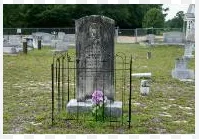Legend of Bill Sketoe

William Sketoe, Sr.(June 8, 1818 – December 3, 1864) was a circuit riding Methodist minister from the south Alabama town of Newton, whose lynchihng there on December 3, 1864 gave birth to one of Alabama's best-known ghost stories. While locally told stories of his life usually say that he was hanged on trumped-up charges of desertion from the Confederate Army, other sources show that he was killed for allegedly aiding pro-Union renegades in the area. Whatever the reason for his murder, a shallow hole dug beneath Sketoe's feet during the hanging (to accommodate his large frame) ultimately led to stories about "the hole that won't stay filled." According to witnesses, this hole never disappeared—even after being filled numerous times—retaining its original dimensions for the next 125 years.Sketoe's tale became a staple of Southern folklore, and was later immortalized by Alabama author Kathryn Tucker Windham in her book 13 Alabama Ghosts and Jeffrey. His hanging site remained a local tourist attraction for decades, and continues to attract visitors even though the hole itself recently disappeared due to flooding in the area. Today the site of Sketoe's lynching lies beneath the Alabama Highway 134 bridge over the Choctawhatchee River, and a monument to Sketoe has been erected nearby.
His LifeWhile much of Bill Sketoe's story is difficult to reconstruct with certainty, he is known to have resided in Newton, Alabama prior to the Civil War,and to have been lynched there on December 3, 1864.The main source for his tale is Kathryn Tucker Windham's 13 Alabama Ghosts and Jeffrey, which tells the legend of Sketoe's life and death as it has been related for generations in and around Newton. However, certain details of this story—such as Sketoe's alleged Confederate war service and the precise reason for his lynching—are subject to controversy based upon other available records. While the legend attributes his death to an ultimately romantic cause (Sketoe's desire to care for his desperately ill spouse), other accounts hint at far more sinister reasons behind his demise, involving Sketoe's alleged (but never proven) collaboration with Unionist local guerrillas.According to the legend, Sketoe was born in Madrid, Spain on June 8, 1818, and came to Dale County, Alabama as a boy with his father. He seemed to be well liked in the community, and chose the ministry as his vocation. While serving as a circuit rider in the Wiregrass area, Sketoe met and married Sarah Clemmons, with whom he ultimately fathered eight children. Sketoe allegedly entered the southern Army during the Civil War, though government archives contain no record of his service in any Confederate unit or local militia. Sketoe supposedly served until the fall of 1864, when he received word that his wife had fallen ill. He accordingly resolved to return home until his spouse had recovered—or so the story goes.Regardless of the truth or falsehood behind this or any version of Sketoe's tale, one fact is certain: Sketoe, for whatever reason, ultimately ran afoul of the Newton Home Guard commanded by Joseph Breare—and that led to his murder.Two different versions exist as to the cause of Sketoe's death. The legend (as related by Windham) says that although Sketoe offered papers indicating that he had hired a substitute to serve in his place (according to the story), the Home Guard refused to believe him, and Breare decided to hang him as a deserter. An alternative view of the reasons behind Sketoe's lynching is provided by historian David Williams in his book Rich Man's War: Caste, Class, and Confederate Defeat in the Lower Chattahoochee Valley. Williams indicates that Sketoe was suspected of helping John Ward, the leader of a local band of deserters and pro-Union guerrillas. Ward had ambushed a Confederate ammunition transport in Dale County two months earlier, killing an officer; one of Breare's men had subsequently been shot during a skirmish with Ward near the current county seat county of Ozark. Breare had tried to hang three local men for alleged collaboration in the attack on the ammunition train, but was prevented from doing so by another Confederate officer due to lack of evidence against them. Although Sketoe was never formally charged or tried for his own alleged acts of collusion with Ward, and although not one piece of hard evidence was ever publicly produced to corroborate Breare's allegations of treason, the Home Guard commander apparently decided to make Sketoe his third victim, anyway.According to the legend, Sketoe was waylaid on the afternoon of December 3, 1864, as he crossed the wooden bridge over the Choctawhatchee River north of Newton. Breare and his men dragged the preacher into the nearby woods, beating him and forcing him to crawl through the sand while they prepared to kill him. Sketoe was next hauled to a waiting buggy, and a rope was thrown over a post oak limb and put around his neck. A friend of Sketoe's happened by the scene at this time; unable to dissuade the Home Guard from their intended course, he ran to Newton for help. Anxious to get on with the hanging, Breare asked Sketoe if he had any last words; he asked if he might pray. However instead of praying for himself, as his killers expected, he began to pray for them, instead; this so infuriated the militiamen that Breare lashed at the horse hitched to the buggy, leaving Sketoe dangling from the tree limb.In their haste to carry out Sketoe's summary execution, Breare and his men failed to take their victim's size into account. Sketoe was tall, and his weight bent the limb to the point that his feet touched the ground. One of Breare's men dug a hole beneath the minister's feet, which allowed Sketoe to strangle to death before his friends could return. Sketoe was buried in nearby Mt. Carmel cemetery, his epitaph reads: "gone, but not forgotten."